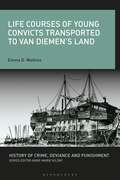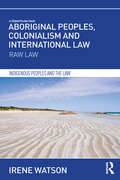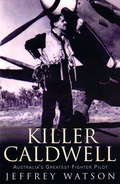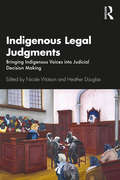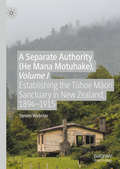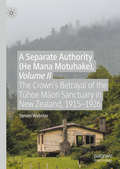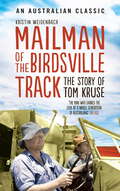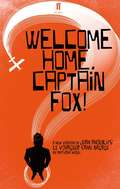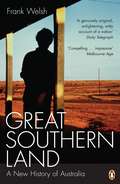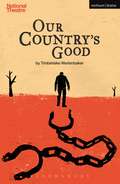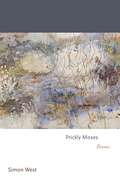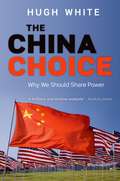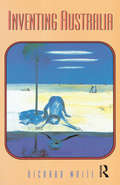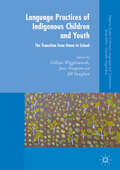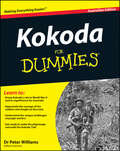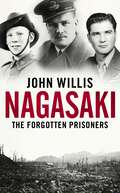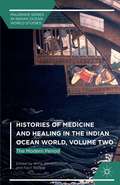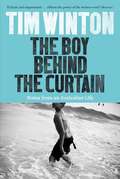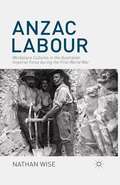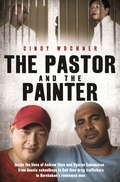- Table View
- List View
Life Courses of Young Convicts Transported to Van Diemen's Land (History of Crime, Deviance and Punishment)
by Emma D. WatkinsDrawing on digital criminal records, this book traces the life courses of young convicts who were sentenced at the Old Bailey and transported to Van Diemen's Land in the early 19th century. It explores the everyday lives of the convicts pre- and post-transportation, focusing on their crimes, punishments, education, employment and family life right up to their deaths. Emma D. Watkins contextualizes these young convicts within the punishment system, economy and culture that they were thrust into by their forced movement to Australia. This allows an understanding of the factors which determined their chances of achieving a 'settled life' away from crime in the colony.Packed with case studies offering vivid accounts of the offenders' lives, Life Courses of Young Convicts Transported to Van Diemen's Land makes an important contribution to the history of transportation, social history and Australian history.
Life Courses of Young Convicts Transported to Van Diemen's Land (History of Crime, Deviance and Punishment)
by Emma D. WatkinsDrawing on digital criminal records, this book traces the life courses of young convicts who were sentenced at the Old Bailey and transported to Van Diemen's Land in the early 19th century. It explores the everyday lives of the convicts pre- and post-transportation, focusing on their crimes, punishments, education, employment and family life right up to their deaths. Emma D. Watkins contextualizes these young convicts within the punishment system, economy and culture that they were thrust into by their forced movement to Australia. This allows an understanding of the factors which determined their chances of achieving a 'settled life' away from crime in the colony.Packed with case studies offering vivid accounts of the offenders' lives, Life Courses of Young Convicts Transported to Van Diemen's Land makes an important contribution to the history of transportation, social history and Australian history.
Aboriginal Peoples, Colonialism and International Law: Raw Law (Indigenous Peoples and the Law)
by Irene WatsonThis work is the first to assess the legality and impact of colonisation from the viewpoint of Aboriginal law, rather than from that of the dominant Western legal tradition. It begins by outlining the Aboriginal legal system as it is embedded in Aboriginal people’s complex relationship with their ancestral lands. This is Raw Law: a natural system of obligations and benefits, flowing from an Aboriginal ontology. This book places Raw Law at the centre of an analysis of colonisation – thereby decentring the usual analytical tendency to privilege the dominant structures and concepts of Western law. From the perspective of Aboriginal law, colonisation was a violation of the code of political and social conduct embodied in Raw Law. Its effects were damaging. It forced Aboriginal peoples to violate their own principles of natural responsibility to self, community, country and future existence. But this book is not simply a work of mourning. Most profoundly, it is a celebration of the resilience of Aboriginal ways, and a call for these to be recognised as central in discussions of colonial and postcolonial legality. Written by an experienced legal practitioner, scholar and political activist, AboriginalPeoples, Colonialism and International Law: Raw Law will be of interest to students and researchers of Indigenous Peoples Rights, International Law and Critical Legal Theory.
Aboriginal Peoples, Colonialism and International Law: Raw Law (Indigenous Peoples and the Law)
by Irene WatsonThis work is the first to assess the legality and impact of colonisation from the viewpoint of Aboriginal law, rather than from that of the dominant Western legal tradition. It begins by outlining the Aboriginal legal system as it is embedded in Aboriginal people’s complex relationship with their ancestral lands. This is Raw Law: a natural system of obligations and benefits, flowing from an Aboriginal ontology. This book places Raw Law at the centre of an analysis of colonisation – thereby decentring the usual analytical tendency to privilege the dominant structures and concepts of Western law. From the perspective of Aboriginal law, colonisation was a violation of the code of political and social conduct embodied in Raw Law. Its effects were damaging. It forced Aboriginal peoples to violate their own principles of natural responsibility to self, community, country and future existence. But this book is not simply a work of mourning. Most profoundly, it is a celebration of the resilience of Aboriginal ways, and a call for these to be recognised as central in discussions of colonial and postcolonial legality. Written by an experienced legal practitioner, scholar and political activist, AboriginalPeoples, Colonialism and International Law: Raw Law will be of interest to students and researchers of Indigenous Peoples Rights, International Law and Critical Legal Theory.
Killer Caldwell: Australia’s Greatest Fighter Pilot (Hachette Military Collection)
by Jeffrey WatsonClive 'Killer' Caldwell was a natural and brilliant pilot, a superb shot, and a born leader. He saw action against the Germans, Italians and Japanese, and remains Australia's greatest ever fighter pilot.Born and brought up in Sydney, it was obvious from an early age that nothing would stand in Caldwell's way. He bluffed his way into the RAAF, then made sure that he was posted to exactly where he thought he should be.His ability was unquestioned by all those around him, and he devised the vital 'shadow shooting' technique which contributed so much to Allied success in the air in the north African campaign, and in northern Australia. But he was never afraid of voicing his opinions to all those above and below him, be it about the training of pilots, or the equipping of Spitfires for use against the Japanese - and for trying to run the show his way...Caldwell ended his military career in the Morotai Mutiny in 1945, where he and a number of other Australian pilots tried to resign their commisions in protest at not being allowed by General MacArthur - and the RAAF - to take part in the main action. And then he was embroiled in the Barry inquiry into booze smuggling by him and other pilots...Killer Caldwell is a colourful portrait of a colourful Australian.
Indigenous Legal Judgments: Bringing Indigenous Voices into Judicial Decision Making
by Nicole Watson Heather DouglasThis book is a collection of key legal decisions affecting Indigenous Australians, which have been re-imagined so as to be inclusive of Indigenous people’s stories, historical experience, perspectives and worldviews. In this groundbreaking work, Indigenous and non-Indigenous scholars have collaborated to rewrite 16 key decisions. Spanning from 1889 to 2017, the judgments reflect the trajectory of Indigenous people’s engagements with Australian law. The collection includes decisions that laid the foundation for the wrongful application of terra nullius and the long disavowal of native title. Contributors have also challenged narrow judicial interpretations of native title, which have denied recognition to Indigenous people who suffered the prolonged impacts of dispossession. Exciting new voices have reclaimed Australian law to deliver justice to the Stolen Generations and to families who have experienced institutional and police racism. Contributors have shown how judicial officers can use their power to challenge systemic racism and tell the stories of Indigenous people who have been dehumanised by the criminal justice system. The new judgments are characterised by intersectional perspectives which draw on postcolonial, critical race and whiteness theories. Several scholars have chosen to operate within the parameters of legal doctrine. Some have imagined new truth-telling forums, highlighting the strength and creative resistance of Indigenous people to oppression and exclusion. Others have rejected the possibility that the legal system, which has been integral to settler-colonialism, can ever deliver meaningful justice to Indigenous people.
A Separate Authority (He Mana Motuhake), Volume I: Establishing the Tūhoe Māori Sanctuary in New Zealand, 1894–1915
by Steven WebsterThis book is an ethnohistorical reconstruction of the establishment in New Zealand of a rare case of Maori home-rule over their traditional domain, backed by a special statute and investigated by a Crown commission the majority of whom were Tūhoe leaders. However, by 1913 Tūhoe home-rule over this vast domain was being subverted by the Crown, which by 1926 had obtained three-quarters of their reserve. By the 1950s this vast area had become the rugged Urewera National Park, isolating over 200 small blocks retained by stubborn Tūhoe "non-sellers". After a century of resistance, in 2014 the Tūhoe finally regained statutory control over their ancestral domain and a detailed apology from the Crown.
A Separate Authority (He Mana Motuhake), Volume II: The Crown’s Betrayal of the Tūhoe Māori Sanctuary in New Zealand, 1915–1926
by Steven WebsterFollowing on from Volume I on the formation of the Urewera District Native Reserve, this monograph examines the period from 1908 to 1926, during which time the Crown subverted Tūhoe control of the UDNR, established a mere decade earlier. While Volume I described how the Tūhoe were able to deploy kin-based power to manipulate Crown power as well as confront one another, this volume describes ways in which the same ancestral descent groups closed ranks to survive nearly two decades of predatory Crown policies determined to dismantle their sanctuary. A relentless Crown campaign to purchase individual Tūhoe land shares ultimately resulted in a misleading Crown scheme to consolidate and relocate Tūhoe land shares, thereby freeing up land for the settlement of non- Tūhoe farmers. By the 1950s, over 200 small Tūhoe blocks were scattered throughout one of the largest National Parks in New Zealand. Although greatly weakened by these policies in terms of kinship solidarity as well as land and other resources, Tūhoe resistance continued until the return of the entire park in 2014—with unreserved apologies and promises of future support. In both volumes of A Separate Authority (He Mana Motuhake), Webster takes the stance of an ethnohistorian: he not only examines the various ways control over the Urewera District Native Reserve (UDNR) was negotiated, subverted or betrayed, and renegotiated during this time period, but also focuses on the role of Māori hapū, ancestral descent groups and their leaders, including the political economic influence of extensive marriage alliances between them. The ethnohistorical approach developed here may be useful to other studies of governance, indigenous resistance, and reform, whether in New Zealand or elsewhere.
Mailman of the Birdsville Track: The story of Tom Kruse
by Kristin WeidenbachThe truly classic Australian story of Tom Kruse - legendary mailman of the Birdsville Track.For the people who lived in the desert between Marree and Birdsville, contact with the outside world was hard and sporadic - but one man was their lifeline: Tom Kruse. For more than twenty years he was the connection with the outside world for the families, station workers and others who lived along the Birdsville Track.Tom delivered everything from the mail and newspapers to fuel and food - whole communities waited in anticipation for him to drop off their supplies. But it was a hard life, from regularly making running repairs to his truck to unloading and reloading tons of stores so that he could ferry his cargo across flooded creeks. Come sandhills, hell or high water, Tom Kruse kept faith with the locals up and down the Track.Tom was a real Australian hero - and no matter what happened, the mail always got through.'Told with honesty and vigour' - Sydney Morning Herald'A tribute to a man who earned the love of a whole generation of Australians and shows us that the pioneer characteristics of guts and good-natured stoicism are still beautiful' - The Age'Full of characters' - Daily Telegraph
Welcome Home, Captain Fox! (Faber Drama Ser.)
by Anthony WeighIt's the legendary hot summer of 1959 and while the Cold War rages and America tunes into I Love Lucy, Captain Jack Fox - believed missing in action in the fields of France fifteen years before - is about to be reunited with his family in the Hamptons.But is this really Jack Fox? And if it isn't, who is this man? And why are there twenty-two other families so intent on claiming him as their own?A sparkling comedy of identity, lost and found, based on Jean Anouilh's hit 1937 play, Le Voyageur sans bagage, Anthony Weigh's Welcome Home, Captain Fox! premiered at the Donmar Warehouse, London, in February 2016.
Great Southern Land: A New History of Australia
by Frank WelshAustralia is a dynamic multi-cultural society, viewed by many as the world's most desirable place to live. Here Frank Welsh traces Australia's intriguing and varied history to examine how this society emerged, from its ancient Aborigine tribes and earliest British convict settlements to today's modern nation - one that retains strong links with its colonial past but is increasingly independent and diverse. While full of admiration for Australia, Welsh also exposes national myths and confronts the darker side of its history - oppression of the Aboriginal peoples and the 'White Australia' policy - and places the country in a global context, considering the changing relationship with Britain and its Asian neighbours, as well as more recent alliances with the US.Original, provocative and entertaining, Great Southern Land provides the most comprehensive one-volume history of this endlessly fascinating nation.
Our Country's Good (Modern Plays)
by Timberlake WertenbakerObserved by a lone, mystified Aboriginal Australian, the first convict ship arrives in Botany Bay, 1788, crammed with England's outcasts. Colony discipline in this vast and alien land is brutal. Three proposed public hangings incite an argument: how best to keep the criminals in line, the noose or a more civilised form of entertainment?The ambitious Second Lieutenant Ralph Clark steps forward with a play. But as the mostly illiterate cast rehearses, and a sense of common purpose begins to take hold, the young officer's own transformation is as marked and poignant as that of his prisoners.A profoundly humane piece of theatre, steeped in suffering yet charged with hope, Timberlake Wertenbaker's Our Country's Good (based on a true story) celebrates the redemptive power of art.It premiered at the Royal Court Theatre, london, in 1988, winning the Laurence Olivier Play of the Year Award. This edition was published to coincide with a major revival production at the National Theatre, which opened on 19 August 2015.
Our Country's Good: Based On The Novel 'the Playmaker' By Thomas Keneally (Modern Plays)
by Timberlake WertenbakerObserved by a lone, mystified Aboriginal Australian, the first convict ship arrives in Botany Bay, 1788, crammed with England's outcasts. Colony discipline in this vast and alien land is brutal. Three proposed public hangings incite an argument: how best to keep the criminals in line, the noose or a more civilised form of entertainment?The ambitious Second Lieutenant Ralph Clark steps forward with a play. But as the mostly illiterate cast rehearses, and a sense of common purpose begins to take hold, the young officer's own transformation is as marked and poignant as that of his prisoners.A profoundly humane piece of theatre, steeped in suffering yet charged with hope, Timberlake Wertenbaker's Our Country's Good (based on a true story) celebrates the redemptive power of art.It premiered at the Royal Court Theatre, london, in 1988, winning the Laurence Olivier Play of the Year Award. This edition was published to coincide with a major revival production at the National Theatre, which opened on 19 August 2015.
Prickly Moses: Poems
by Simon WestCompelling poems that celebrate language as it encounters the nameless variety of the natural world, from Australia to ItalyAn uncanny blend of the external and the intimate has been a hallmark of Simon West’s poetry for nearly twenty years. In this new collection, the Australian poet and Italianist delights in the transforming and endlessly varied powers of naming and speaking. West’s intensely regional focus stands in dialogue with Europe and antiquity. Landscapes reveal the tangle of their historical dimensions, as the rivers of both the Goulburn Valley in southeastern Australia and the Po Valley in northern Italy merge and flow into the wider currents of the Southern Ocean. Again and again, language and the senses throw themselves into the nameless riot of the world, from eucalypts and clouds to a medieval bell tower and the sounds a pencil makes as it crosses a page.
Inventing Australia: Images And Identity, 1688-1980 (Australian Experience Ser. #No. 3)
by Richard White'White sets himself a most ambitious task, and he goes remarkably far to achieving his goals. Very few books tell so much about Australia, with elegance and concision, as does his' - Professor Michael Roe'Stimulating and informative. an antidote to the cultural cringe' - Canberra Times'To be Australian': what can that mean? Inventing Australia sets out to find the answers by tracing the images we have used to describe our land and our people - the convict hell, the workingman's paradise, the Bush legend, the 'typical' Australian from the shearer to the Bondi lifesaver, the land of opportunity, the small rich industrial country, the multicultural society.The book argues that these images, rather than describing an especially Australian reality, grow out of assumptions about nature, race, class, democracy, sex and empire, and are 'invented' to serve the interests of particular groups.There have been many books about Australia's national identity; this is the first to place the discussion within an historical context to explain how Australians' views of themselves change and why these views change in the way they do.
Inventing Australia
by Richard White'White sets himself a most ambitious task, and he goes remarkably far to achieving his goals. Very few books tell so much about Australia, with elegance and concision, as does his' - Professor Michael Roe'Stimulating and informative. an antidote to the cultural cringe' - Canberra Times'To be Australian': what can that mean? Inventing Australia sets out to find the answers by tracing the images we have used to describe our land and our people - the convict hell, the workingman's paradise, the Bush legend, the 'typical' Australian from the shearer to the Bondi lifesaver, the land of opportunity, the small rich industrial country, the multicultural society.The book argues that these images, rather than describing an especially Australian reality, grow out of assumptions about nature, race, class, democracy, sex and empire, and are 'invented' to serve the interests of particular groups.There have been many books about Australia's national identity; this is the first to place the discussion within an historical context to explain how Australians' views of themselves change and why these views change in the way they do.
Language Practices of Indigenous Children and Youth: The Transition from Home to School (Palgrave Studies in Minority Languages and Communities)
by Gillian Wigglesworth Jane Simpson Jill VaughanThis book explores the experiences of Indigenous children and young adults around the world as they navigate the formal education system and wider society. Profiling a range of different communities and sociolinguistic contexts, this book examines the language ecologies of their local communities, schools and wider society and the approaches taken by these communities to maintain children’s home languages. The authors examine such complex themes as curriculum, translanguaging, contact languages and language use as cultural practice. In doing so, this edited collection acts as a first step towards developing solutions which address the complexity of the issues facing these children and young people. It will appeal to students and scholars of sociolinguistics, applied linguistics and community development, as well as language professionals including teachers, curriculum developers, language planners and educators.
Kokoda Trail for Dummies
by Peter WilliamsEverything you need to know about the Kokoda Trail and its place in Australian history Interest in the Kokoda Trail is growing rapidly among many Australians, both for its attraction as a hiking destination and for its historical significance. Kokoda For Dummies offers a fast track tool for learning everything you need to know about this unique thoroughfare, in one concise volume. Part history book, part practical guide, Kokoda For Dummies is perfect both for those considering following our Diggers’ footsteps along ‘the track’ or armchair travellers who want to learn about its history. Covering the full history of the Kokoda Trail, from its beginnings as an overland mail route to the fierce battles between the Australians and the Japanese that took place along its length during World War II, the book also includes important information on walking the trail yourself. From the steps you need to take to get ready to what to bring, Kokoda For Dummies is the definitive resource for anyone looking for a comprehensive overview of this significant landmark. Focuses on walking the track as a pilgrimage and a history lesson for history buffs and hiking enthusiasts alike Covers the health and safety concerns involved with walking the track, including a basic Kokoda itinerary Contains eyewitness accounts of the Kokoda battles gleaned from interviews conducted with Australian and Japanese war veterans A comprehensive but accessible history of the Kokoda Trail and its significance to Australia, in one volume.
Kokoda Trail for Dummies
by Peter WilliamsEverything you need to know about the Kokoda Trail and its place in Australian history Interest in the Kokoda Trail is growing rapidly among many Australians, both for its attraction as a hiking destination and for its historical significance. Kokoda For Dummies offers a fast track tool for learning everything you need to know about this unique thoroughfare, in one concise volume. Part history book, part practical guide, Kokoda For Dummies is perfect both for those considering following our Diggers’ footsteps along ‘the track’ or armchair travellers who want to learn about its history. Covering the full history of the Kokoda Trail, from its beginnings as an overland mail route to the fierce battles between the Australians and the Japanese that took place along its length during World War II, the book also includes important information on walking the trail yourself. From the steps you need to take to get ready to what to bring, Kokoda For Dummies is the definitive resource for anyone looking for a comprehensive overview of this significant landmark. Focuses on walking the track as a pilgrimage and a history lesson for history buffs and hiking enthusiasts alike Covers the health and safety concerns involved with walking the track, including a basic Kokoda itinerary Contains eyewitness accounts of the Kokoda battles gleaned from interviews conducted with Australian and Japanese war veterans A comprehensive but accessible history of the Kokoda Trail and its significance to Australia, in one volume.
Nagasaki: The Forgotten Prisoners
by John WillisThis is one of the most remarkable untold stories of the Second World war. At 11.02 am on an August morning in 1945 America dropped the world's most powerful atomic bomb on the Japanese port city of Nagasaki. The most European city in Japan was flattened to the ground 'as if it had been swept aside by a broom'. More than 70,000 Japanese were killed. At the time, hundreds of Allied prisoners of war were working close to the bomb's detonation point, as forced labourers in the shipyards and foundries of Nagasaki.These men, from the Dales of Yorkshire and the dusty outback of Australia, from the fields of Holland and the remote towns of Texas, had already endured an extraordinary lottery of life and death that had changed their lives forever. They had lived through nearly four years of malnutrition, disease, and brutality. Now their prison home was the target of America's second atomic bomb.In one of the greatest survival stories of the Second World War, we trace their astonishing experiences back to bloody battles in the Malayan jungle, before the dramatic fall of Fortress Singapore, the mighty symbol of the British Empire. This abject capitulation was followed by surrender in Java and elsewhere in the East, condemning the captives to years of cruel imprisonment by the Japanese. Their lives grew evermore perilous when thousands of prisoners were shipped off to build the infamous Thai-Burma Railway, including the Bridge on the River Kwai. If that was not harsh enough, POWs were then transported to Japan in the overcrowded holds of what were called hell ships. These rusty buckets were regularly sunk by Allied submarines, and thousands of prisoners lived through unimaginable horror, adrift on the ocean for days. Some still had to endure the final supreme test, the world's second atomic bomb.The prisoners in Nagasaki were eyewitnesses to one of the most significant events in modern history but writing notes or diaries in a Japanese prison camp was dangerous. To avoid detection, one Allied prisoner buried his notes in the grave of a fellow POW to be reclaimed after the war, another wrote his diary in Irish. Now, using unpublished and rarely seen notes, interviews, and memoirs, this unique book weaves together a powerful chorus of voices to paint a vivid picture of defeat, endurance, and survival against astonishing odds.
Histories of Medicine and Healing in the Indian Ocean World, Volume Two: The Modern Period (Palgrave Series in Indian Ocean World Studies)
by Anna Winterbottom Facil TesfayeThe Indian Ocean has been the site of multiple interconnected medical interactions that may be viewed in the context of the environmental factors connecting the region. This interdisciplinary work presents essays on various aspects of disease, medicine, and healing in different locations in and around the Indian Ocean from the eighteenth century to the contemporary era. The essays explore theoretical explanations for disease, concepts of fertility, material culture, healing in relation to diplomacy and colonialism, public health, and the health of slaves and migrant workers. This book will appeal to academics and graduate students working in the fields of medical and scientific history, as well as in the growing fields of Indian Ocean studies and global history.
The Boy Behind the Curtain: Notes From an Australian Life
by Tim Winton'Eclectic and impassioned, a collection that affirms the power of the written word' ObserverThe Boy Behind the Curtain is a portrait of a life, a place and a man. In this deeply personal collection of true stories and essays Tim Winton shows how moments from his childhood and life growing up have shaped his views on class, faith, fundamentalism, the environment, and - most pressingly - how all his experiences have made him a writer. From unexpected links between car crashes and faith, surfing and writing, to the story of his upbringing in the changing Australian landscape, The Boy Behind the Curtain is an impassioned, funny, joyous, astonishing collection of memories, and Winton's most personal book to date.
Anzac Labour: Workplace Cultures in the Australian Imperial Force during the First World War
by Nathan WiseAnzac Labour explores the horror, frustration and exhaustion surrounding working life in the Australian Imperial Force during the First World War. Based on letters and diaries of Australian soldiers, it traces the history of work and workplace cultures through Australia, the shores of Gallipoli, the fields of France and Belgium, and the Near East.
The Pastor and the Painter: Inside the lives of Andrew Chan and Myuran Sukumaran – from Aussie schoolboys to Bali 9 drug traffickers to Kerobokan's redeemed men
by Cindy WocknerA very personal look at Andrew Chan and Myuran Sukumaran. Cindy Wockner was a journalist reporting the story of two surly drug smugglers. She was there from the beginning and would become a good friend of the two changed men.At 12.35 a.m. on 29 April 2015, Andrew Chan and Myuran Sukumaran were led out in front of a firing squad. Strapped to wooden crosses, they looked straight down the barrels of their killers' rifles. On that day, the Indonesian government did not execute two drug smugglers, they executed a pastor and a painter.But who were Andrew and Myuran?In 2005, the lure of drugs, money, fast cars and a better life led them and seven other Australians into a smuggling plot to import heroin from Indonesia to Australia. Unbeknownst to them all, the Australian Federal Police knew of their plan and tipped off the Indonesian authorities. Charged with drug trafficking, Myuran and Andrew were found guilty and sentenced to death. Andrew was 21 years old. Myuran was 24.At the time, Cindy Wockner was the Indonesia correspondent for News Limited: for a decade she covered their story and she got to know Myuran, Andrew and their families. They let her into their lives and she watched them transform from angry, defiant young inmates into fully rehabilitated, good men.This is the intimate, and untold, story of Andrew and Myuran. It details their redemption inside Kerobokan prison and their passion for helping others - through Andrew's growing commitment to his faith and Myu's burgeoning artistic talent. It reveals the boys they were and the men they became, in a potent cautionary tale and a poignant reminder of what we all lose when we ignore the power of mercy.'gripping' DAILY TELEGRAPH on Cindy Wockner and Madonna King's BALI 9
